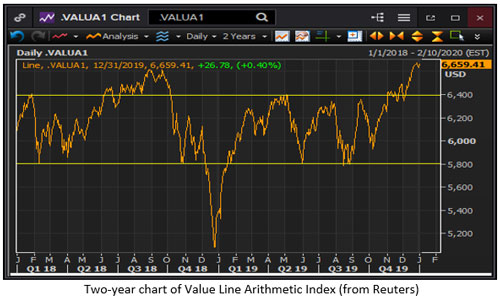It’s hard to believe we are entering the year 2020. I can remember as an adolescent thinking that 2020 was so far in the future (I would be turning 60 years old) and having little sense of what life would be like at that time. And now here we are. Many of the innovations forecast for this era, such as flying cars, robots for the home and laser guns, have not materialized (yet), but the power of everyday gadgets we now take for granted—smartphones and devices like Alexa and Google Home, for example—is certainly a technological marvel.
Predicting the future is often little more than a guess, whether one is looking ahead 40 years, a single year or even one day. As the saying goes, “Tomorrow is promised to no one.” Consider the mindset of investors exactly a year ago. Stocks around the world had fallen between 10% and 20%, and investors were concerned about the global economy slipping into recession, undermined by ongoing trade wars between the U.S. and many of its major trading partners. Forecasts for the year were quite modest, if not outright negative, as we entered 2019.
As we note regularly in these newsletters, the markets often behave differently than what experts have predicted. And once again, we have a perfect example of why we at FSA focus on the overall trends of the market rather than the news headlines. Rather than slipping into recession, the economy in 2019 plugged along at around 2% for the year, while global stock markets finished one of their best years of the decade. FSA clients participated in the stock market rally as well, with most finishing the year at all-time highs.
The following two charts show why we are comfortable with our strategies at their maximum equity allocations. The first chart (the S&P 500 index) shows stocks breaking above their trading range into new highs during the fourth quarter. But it was the confirming breakout of the broader Value Line Index of 1700 stocks (in the second chart) that gave us the confidence to bring all the strategies to their full allocation of stocks. From a technical perspective, the overall trend for stocks looks healthy as we enter the new decade of the 2020s.
Initial Thoughts for 2020
Recognizing full well that our vision looking toward the future is always fuzzy, what clues might we find as we take our first peek into the new year (and the new decade)? Though optimistic overall about current market trends, we do see evidence that could point to trouble at some point in 2020. Refer to the first chart above of the S&P 500 index. Notice that all the (net) gain for the past two years occurred in the fourth quarter of 2019. Fully half of last year’s gain reflected the recovery of stock market losses from the fourth quarter of 2018. And while it has been encouraging to see stocks work their way back up, to reach new highs, it would not take much of a correction to wipe out the new gains from the fourth quarter of last year.
And of course, the S&P 500 index is one of the better-looking indexes. The Value Line chart (above) is struggling to break out to new highs. A chart of foreign stocks (not included here) shows they are far below their prior highs. Overall, this makes us less confident about the overall health of the market. We prefer to see the broader indexes doing as well, if not better, than the narrower indexes.
Economically speaking, we see a mixed bag. The consumer market remains strong, thanks to low unemployment. This has kept the economy chugging along and has helped the technology-oriented sectors perform well. On the other hand, the manufacturing sector continues to languish, a victim of the ongoing trade war with China in particular. Recent data suggest that the manufacturing component of the economy is actually in recession. And while the recent increase in tensions between the U.S. and Iran have not had a big impact on stocks so far, it is an issue that could flare up down the road.
Currently, most FSA portfolios include funds that are invested primarily in large U.S. companies. Recently, we made a foray into international stocks, but the allocation is only 5% at this time. Further improvement in the overall trends for foreign stocks will lead us to consider increasing that allocation. For portfolios that include bonds, we have split that bond component into more aggressive high yield bonds and more conservative intermediate-term funds.
As we step into the new year, the overall technical picture supports our fully invested positioning. It is not a time to become complacent, however, as we recognize that our view of the past is always 20/20, while our view of the future is decidedly less clear.
Portfolio Update
Keep in mind that because we manage clients’ portfolios individually, the holdings and results for your particular accounts may differ somewhat from the averages.
Income (Strategy 1)
The year 2019 turned out to be a surprisingly good year for bonds, as most experts had predicted another tough year for bonds, given that the Federal Reserve seemed headed toward raising interest rates (which got reversed). During the quarter we sold a lagging intermediate fund and replaced it with a fund that owns preferred securities. Currently, the Income portfolios hold 35% in high yield bonds, 35% in higher quality intermediate-term funds, and 25% in high yield municipal bond funds. The money market position is less than 5%.
Income & Growth (Strategy 2)
During the fourth quarter, we brought this strategy up to its full equity allocation of 50% by adding two exchange-traded funds (ETFs). We reduced our emerging markets bond position to help make room for the added stock fund purchases. As of year end, these portfolios held 50% in equities, 25% in high yield bond funds, 20% in high quality bond funds, and 5% in money market funds.
Conservative Growth (Strategy 3)
During the fourth quarter, we increased the equity allocation up to its maximum level of 75% by adding an international fund and a large-cap growth fund, while reducing our intermediate bond and cash allocations. Currently, these portfolios hold 74% in stock funds, with 17% in high yield bond funds, 5% in intermediate-term bonds, and 4% in money market funds.
Core Equity (Strategy 4)
During the quarter, we added an emerging markets fund and increased the U.S. stock fund position which brought the portfolios to their maximum level of 95%. As of year-end, this strategy held roughly 90% in equities, 5% in gold, and 5% in money market funds.
Tactical Growth (Strategy 5)
As stocks rallied late in the year, we added an emerging markets fund to the portfolios and a health care sector fund. As we enter the new year, these portfolios hold roughly 45% to 55% in diversified equity funds, 5% in emerging markets funds, 35% to 45% in various sector funds, with 5% in money market funds.
Sector Rotation (Strategy 6)
This aggressive strategy continues to search for strong sectors within the stock market, but the rotation and volatility have made it difficult to keep pace with the broad market. As of the January rotation, the portfolios hold semiconductor, banking, health care, biotechnology, basic materials, and leisure stocks.
Please remember to inform your advisor of any changes in your life that could affect your investment objective and how we manage your money.
Ronald Rough, CFA
Director of Portfolio Management
Disclosures are available at https://fsainvest.com/disclosures/market-update/.
FSA’s current written Disclosure Brochure and Privacy Notice discussing our current advisory services and fees is also available at https://fsainvest.com/disclosures/ or by calling 301-949-7300.






